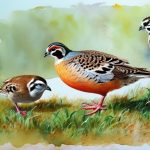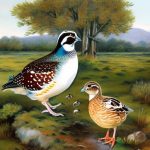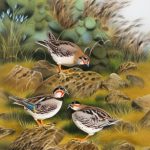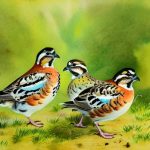Quail breeding in Michigan has become increasingly popular in recent years, as more and more people are discovering the joys of raising these small game birds. Michigan’s diverse landscape and climate make it an ideal location for quail breeding, with a variety of quail breeds thriving in the state. Whether for hunting, conservation, or simply as pets, quail breeds in Michigan offer a unique and rewarding experience for enthusiasts.
Michigan’s quail breeds are known for their adaptability to the state’s climate and terrain, making them a popular choice for both novice and experienced breeders. With proper care and attention, quail can thrive in Michigan’s diverse environments, from the wooded areas of the Upper Peninsula to the open fields of the Lower Peninsula. In this article, we will explore the popular quail breeds in Michigan, their characteristics, best practices for raising them, breeding and reproduction, housing and care, as well as hunting and conservation efforts in the state.
Key Takeaways
- There are several quail breeds that are popular in Michigan, each with its own unique characteristics and traits.
- Some of the popular quail breeds in Michigan include the Northern Bobwhite, Japanese Quail, and Coturnix Quail.
- Quail breeds in Michigan are known for their adaptability to the local climate and their ability to thrive in various environments.
- Best practices for raising quail in Michigan include providing proper housing, nutrition, and protection from predators.
- Quail breeding and reproduction in Michigan can be a rewarding experience, but it requires careful planning and management to ensure the health and well-being of the birds.
Popular Quail Breeds in Michigan
1. Bobwhite Quail: The Bobwhite quail is one of the most popular quail breeds in Michigan, known for its distinctive call that sounds like “bob-white.” These birds are native to the eastern United States and have adapted well to Michigan’s landscape. They are prized for their delicious meat and are a popular game bird for hunting enthusiasts. Bobwhite quail are relatively easy to raise and are known for their hardiness and adaptability to various environments.
2. Coturnix Quail: Also known as Japanese quail, Coturnix quail are another popular breed in Michigan. These birds are smaller than Bobwhite quail and are known for their fast growth and high egg production. Coturnix quail come in a variety of colors, including brown, white, and speckled, making them an attractive addition to any quail breeding operation. They are also known for their gentle disposition, making them a popular choice for those looking to raise quail as pets.
Characteristics of Quail Breeds in Michigan
Bobwhite quail are known for their distinctive call, which sounds like “bob-white,” and their mottled brown and white plumage. They are ground-dwelling birds that prefer open grasslands and brushy areas, making them well-suited to Michigan’s diverse landscape. Bobwhite quail are social birds that thrive in small flocks and are relatively easy to care for, making them an ideal choice for novice breeders.
Coturnix quail, on the other hand, are smaller than Bobwhite quail and come in a variety of colors, including brown, white, and speckled. They are known for their fast growth and high egg production, making them a popular choice for those looking to raise quail for meat or eggs. Coturnix quail are also known for their gentle disposition, making them a popular choice for those looking to raise quail as pets.
Best Practices for Raising Quail in Michigan
When it comes to raising quail in Michigan, there are several best practices that breeders should keep in mind to ensure the health and well-being of their birds. First and foremost, providing a suitable habitat is essential for quail to thrive. This includes a spacious enclosure with plenty of room to move around, as well as access to fresh water and a balanced diet.
In addition to proper housing and nutrition, breeders should also pay close attention to the social dynamics of their quail flock. Quail are social birds that thrive in small groups, so it’s important to provide them with plenty of space and opportunities for social interaction. Additionally, regular health checks and preventative measures against common diseases and parasites are crucial for maintaining a healthy quail population.
Quail Breeding and Reproduction in Michigan
Breeding and reproduction are important aspects of quail husbandry in Michigan. Both Bobwhite and Coturnix quail reach sexual maturity at around 8-10 weeks of age, at which point they can begin mating and laying eggs. Breeders should provide suitable nesting areas for their quail, as well as a balanced diet to support healthy egg production.
Once the eggs are laid, they should be collected and placed in an incubator to ensure proper development. Incubation periods vary depending on the breed of quail, but typically range from 17-24 days. Once the chicks hatch, they should be provided with a warm and safe environment to grow and develop before being introduced to the rest of the flock.
Quail Housing and Care in Michigan

Proper housing and care are essential for the health and well-being of quail in Michigan. Quail should be provided with a spacious enclosure that allows them to move around freely and engage in natural behaviors such as dust bathing and foraging. The enclosure should also provide protection from predators and the elements, with access to fresh water and a balanced diet.
In addition to proper housing, regular health checks and preventative measures against common diseases and parasites are crucial for maintaining a healthy quail population. Breeders should also pay close attention to the social dynamics of their quail flock, providing plenty of space and opportunities for social interaction.
Quail Hunting and Conservation in Michigan
Quail hunting is a popular pastime in Michigan, with both Bobwhite and Coturnix quail being prized game birds. However, due to habitat loss and other environmental factors, quail populations have declined in recent years. As a result, conservation efforts have become increasingly important to protect these beloved birds.
Conservation organizations in Michigan work to preserve and restore quail habitat, as well as educate the public about the importance of conservation efforts. By promoting sustainable hunting practices and habitat restoration, these organizations aim to ensure that future generations can continue to enjoy the thrill of hunting quail in Michigan’s diverse landscapes.
If you’re interested in learning more about quail breeds in Michigan, you might also want to check out this informative article on how many chickens you need for a family of 4. It provides valuable insights into the practical aspects of raising poultry and could offer some helpful tips for managing quail breeds as well.
FAQs
What are the different quail breeds in Michigan?
In Michigan, common quail breeds include the Northern Bobwhite, Coturnix Quail, and Gambel’s Quail.
What are the characteristics of the Northern Bobwhite quail breed?
The Northern Bobwhite is known for its distinctive call, and it is a popular game bird in Michigan. It has a mottled brown and white plumage and a short, rounded tail.
What are the characteristics of the Coturnix quail breed?
The Coturnix Quail, also known as the Japanese Quail, is a small, plump bird with a speckled brown and white plumage. It is known for its rapid growth and high egg production.
What are the characteristics of the Gambel’s quail breed?
Gambel’s Quail is known for its striking plumage, with a black face, chestnut belly, and a distinctive topknot of feathers. It is native to the southwestern United States, including parts of Michigan.
Are there any specific regulations for raising quail breeds in Michigan?
In Michigan, individuals interested in raising quail should be aware of any local zoning regulations, as well as state regulations regarding the keeping of game birds. It is important to research and comply with any relevant laws and regulations.
Meet Walter, the feathered-friend fanatic of Florida! Nestled in the sunshine state, Walter struts through life with his feathered companions, clucking his way to happiness. With a coop that’s fancier than a five-star hotel, he’s the Don Juan of the chicken world. When he’s not teaching his hens to do the cha-cha, you’ll find him in a heated debate with his prized rooster, Sir Clucks-a-Lot. Walter’s poultry passion is no yolk; he’s the sunny-side-up guy you never knew you needed in your flock of friends!







